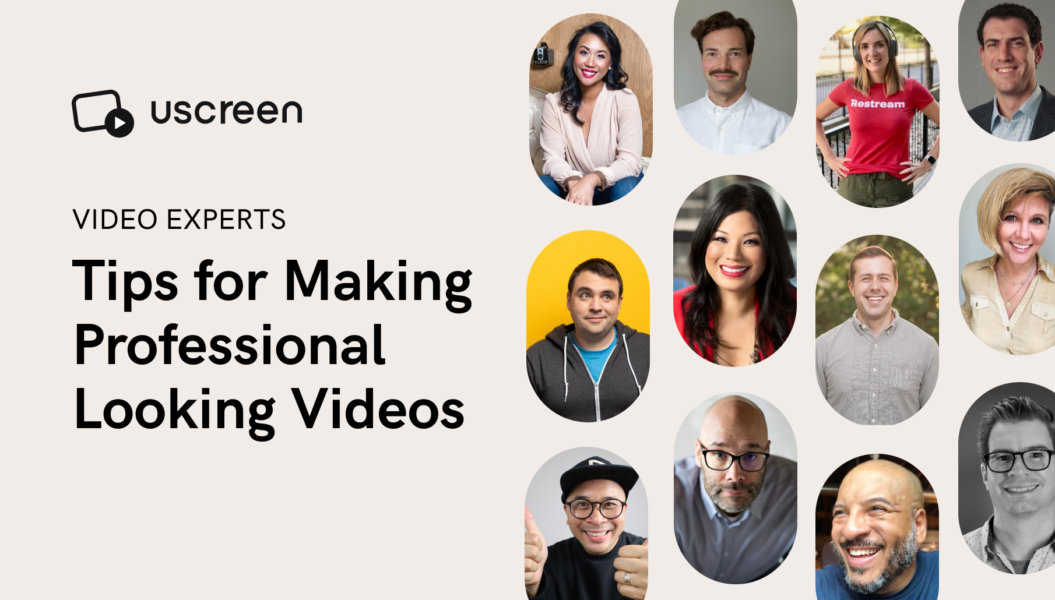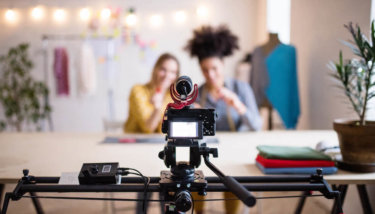We all want to look our best on video. After all, we posted a video to give our business brand a boost and increase sales. However, professionals not used to being in front of a camera often struggle with the best way to present themselves in a positive light.
Take the video below. The person interviewed made five mistakes in the first two minutes. All the mistakes could be avoided with some simple guidelines to follow before shooting a video.
Fortunately, we can learn from this comedy of errors to improve the videos entrepreneurs shoot for their businesses.
Because every business wants to improve their branding, the idea of looking is not a matter of vanity. The image you project enables you to improve the quality of customers who use your product. Video is a critical component to successful branding and promotion.
How do you do improve your brand through video? How do you look good? While there is no magic formula to look good instantly, there are some strategies you can implement to improve the overall flow of your videos.
To help you, we collected experts’ tips from around the internet. Taken together, these tips will help you be more comfortable on camera, improve your engagement on social media and YouTube and elevate your video calls on Zoom and Skype.
Let’s go through the seven tips to look good in your next video:
1. Be Energetic
A camera can be the biggest critic you ever meet. It seems when you display a low energy level and does not miss a beat when your enthusiasm stretches the truth.
For example, Tony Robbins’ videos get millions of views per month. While he was an iconic speaker and leader before he created his YouTube channel, he leveraged his success with energetic videos that inspire.
He is a true believer in Motion creates Emotion. That shines through as he jumps on stage and gets the crowd into a frenzy. It would not work if he didn’t believe it. He is a high-energy person who knows how to build the audience’s interest.
You do not need to be Tony Robbins. However, if you want to have a modicum of success like he achieved, then you should show your emotion. That doesn’t mean you wear your smile like a crazy person or the Joker in Batman.
Instead, smile for the camera and focus on how you can use your nervous energy to give your upcoming video a boost.
2. Make the topic understandable
We often hear intellectuals lament how the Internet gives us all attention deficit disorder. Studies show that our attention span today is only 8 seconds. To keep your audience hooked to your video, you need a quick and clear message.
Unlike the king of jargon below use words that people understand.
As we develop in our profession, we often use more jargon. The challenge is that we forget that our clients do not spend their entire day working on your field of expertise. They do not have the same level of understanding. Otherwise, they would not need our services.
Therefore, cut the jargon from your video and make it easy for prospects to understand how you can help them.
3. Remember to smile
72% of people believe that frequent smilers are secure and successful. What better way to win your audience’s trust than by showing that you are confident about your business and services.
Sunny Lenarduzzi shows how creepy it is when you don’t smile. She calls it the S&B for smile and blink. Her example of what not to do when you are on video is spot-on. She covers many of the challenges people have when shooting their first video.
Finally, you cannot make as much money if you do not smile. Wishpond ran a 5-week A/B split test that discovered how a smiling face increases profits by 10.7%.
If you have trouble smiling on camera or are concerned that your smile will not look genuine, fret not! Practice smiling in front of a mirror. It will relax you when you are on camera, and you detect inadvertent facial tics you didn’t mean to use.
4. Look directly into the camera
Often customers come to us telling about how they have experience talking at an event. The challenge is that speaking in front of a live audience is different from talking on camera. First, you cannot gauge the emotions of the viewer. Second, you have a more limited range of motion.
Unlike on a stage, the camera lens scope limits you where you can look to ensure you capture the audiences’ attention.
The key is to look directly at the camera lens. While it is tempting to look at yourself talking (depending on the camera and webcam in use) or focus on different spots throughout the video, your audience is only right in front of you.
Take heed of the limited space of the camera. Bring it to eye level and focus on it instead of looking around. Remember the first thing Sunny Lenarduzzi said about how needing to smile, maintaining eye contact and also blink.
We are not going to sugarcoat it; everyone looks creepy when keeping their eyes open for too long.
5. Grab the audience attention early
We cannot repeat this statement enough; you have 8 seconds. Now that you have a clear message, you need a quick, clear way to convey your thoughts to your audience.
Marcus Sheridan at the beginning of the video below shows all the creepy things that many business professionals do in their online videos that hinder the impression they make to their audience.
The better you start your video; the more people will watch the rest. For example, don’t start by telling your name and the title of the video. Instead, come up with something compelling to your audience that immediately engrosses your viewer in your topic.
That could be an anecdote, statistic, or a bold claim (which you then back up).
You, viewers, need a reason to keep listening to your podcast or watch your YouTube video. You need to give them that reason early, or they will stop watching.
6. Prepare for your on-camera presentation
Just because you know your business doesn’t mean you explain it clearly. The people who look natural clarifying a process are those who do it on a regular basis.
Depending on how much guidance you need before shooting the video, you might want to create an outline or script. Then practice the video until you are tired of hearing your voice. However, the moment you go on camera, your presentation will seem natural and conversational.
A good idea after a great intro that gets viewers’ attention is to give them some information guiding them to the direction of the video.
Also, if you have more than two points, number them. For example, you can discuss the top three ways–or maybe seven expert tips–to look good on video. People like structure, so they can follow your story on the video.
Otherwise, you are rambling and probably off-topic. That affects how prospects perceive your brand.
Whenever possible add visual cues as well as audio cues to indicate different points. If you say first, use captions or a text callout that shows viewers you are switching to the next topic.
People do NOT always pick up on what you do. That is why you need to make it easy for them to follow you.
Part of that equation is not only giving them the outline. You need to follow the framework as well. Otherwise, no one can follow your lead.
7. Make sure you dress for success
Here is something fun that every video marketer wants to hear. People make snap judgments about you right away. They judge you for your smile (or lack thereof), your posture and other non-verbal communication cues. Finally, your viewers judge you based on what you wear.
While you will never please everyone, you can wear something that fits your target audience. When you watch the video below from Paul McGregor, you sense he is fashionable.
It is not just the British accent. It is the hairstyle, the somewhat unshaven (looks intentional) three goatee, and the chic outfit. Plus, it does not hurt that Paul has a fancy shirt and jacket in the background.
Yes, people like Mark Zuckerberg get away with wearing hoodies for years. However, even he wore a suit when he spoke in front of the Senate recently.
The adage is true: if you look good, you feel good. You do not need to spend your entire day getting dressed. However, you can spend some time finding a clean, ironed shirt to wear. Do NOT dress too flashy unless it suits your audience.
Also, comb your hair and use some hairspray or gel.
Finally, both men and women can use some makeup on the air, whether it is concealer to hide blemishes or powder to darken your skin, so you don’t look like a ghost. Both men and women need this kind of help.
Final Thoughts
After watching the videos above, you hopefully have a better sense of what you should and should not do for your next video.
If you are not able to implement all of the tips immediately, start with the one or two tips you need to use the most to make your videos effective. Once you improve the weakest component of your videos, you can focus on other areas.
Then you will look good (and credible), so your audience wants to watch more of your videos and learn more about your services.
To learn more about creating professional-looking videos including tips on lighting, video editing, strategy, live streaming and more, check out our recent post:







